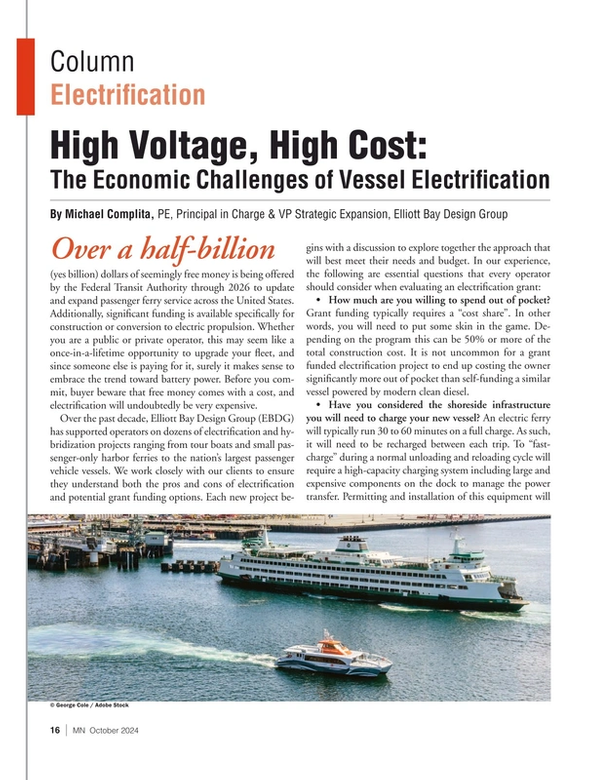
High Voltage, High Cost: The Economic Challenges of Vessel Electrification
Over a half-billion (yes billion) dollars of seemingly free money is being offered by the Federal Transit Authority through 2026 to update and expand passenger ferry service across the United States. Additionally, significant funding is available specifically for construction or conversion to electric propulsion. Whether you are a public or private operator, this may seem like a once-in-a-lifetime opportunity to upgrade your fleet, and since someone else is paying for it, surely it makes sense to embrace the trend toward battery power. Before you commit, buyer beware that free money comes with a cost, and electrification will undoubtedly be very expensive.
Over the past decade, Elliott Bay Design Group (EBDG) has supported operators on dozens of electrification and hybridization projects ranging from tour boats and small passenger-only harbor ferries to the nation's largest passenger vehicle vessels. We work closely with our clients to ensure they understand both the pros and cons of electrification and potential grant funding options. Each new project begins with a discussion to explore together the approach that will best meet their needs and budget. In our experience, the following are essential questions that every operator should consider when evaluating an electrification grant:
- How much are you willing to spend out of pocket? Grant funding typically requires a "cost share". In other words, you will need to put some skin in the game. Depending on the program this can be 50% or more of the total construction cost. It is not uncommon for a grant funded electrification project to end up costing the owner significantly more out of pocket than self-funding a similar vessel powered by modern clean diesel.
- Have you considered the shoreside infrastructure you will need to charge your new vessel? An electric ferry will typically run 30 to 60 minutes on a full charge. As such, it will need to be recharged between each trip. To "fast-charge" during a normal unloading and reloading cycle will require a high-capacity charging system including large and expensive components on the dock to manage the power transfer. Permitting and installation of this equipment will add 30% or more to the total project cost. Charging time may also require changes to your current scheduling.
- Does your local power grid have capacity? Many routes well suited to electrification have been stymied by the lack of available grid capacity. Power providers may also be unwilling to invest in the additional infrastructure necessary to meet your vessel's demand.
- Have you factored in the "fuel" cost? A gallon of diesel costs the same regardless of what time of day you burn it. In regions with surge power pricing models, peak energy cost hours are also usually peak ferry operating hours. Though an electric ferry won't require fuel in the conventional sense, you may ultimately not see a significant reduction in operating cost.
- Do you have the budget for a grant writer? A successful grant pursuit will likely require a significant investment of both time and money up front and there is no guarantee that your application will be selected. If you are successful, you will also need to be prepared to invest additional effort over the course of construction to document and apply for progress payment.
- Other long-term cost considerations include spares and maintenance for both the vessel and dock side systems, battery bank replacement and crew training.
The appeal of a quiet, clean and efficient new electric boat at little to no out-of-pocket expense is universal, and most short-run ferry and tour routes are ideal candidates from a technical perspective. In reality, when all factors are considered, integrating an electrified power system can increase the costs as much as two or more times compared with a conventional diesel-powered vessel. As an example, a new build electric ferry project in the Pacific Northwest was put on hold earlier this year due to a projected shortfall of approximately $13 million in total program budget based in part on shipyard bids for vessel construction exceeding the anticipated cost of $26.6 million. Additionally, a regional operator EBDG is working with is reconsidering a conventional diesel replacement despite their desire for an electric boat based on similar funding concerns.
In other cases, an electric or hybrid system is an ideal alignment of both need and resources. In California, new regulations require all short-run ferries to be electrified by 2026 and operators are leveraging significant additional State level funding to support their transition. Washington State Ferries is in the process of revising both the design and their contracting approach to close the budget gap on the nation's largest electrified passenger vehicle ferries. Projects in both the Gulf and Northeast Regions are also moving ahead based on recent budget validation.
Through thoughtful planning and careful consideration of the total cost including shoreside charging infrastructure, on-shore battery energy storage and modern vessel propulsion technologies, electrification is a viable and environmentally considerate option for many ferry operations. Other options that should be given equal consideration before beginning any newbuild or conversion project include hybrid systems and state-of-the-art advancement in clean diesel emissions reduction. Before committing to any approach, it is also important to understand and consider the true cost of seemingly free money
Read High Voltage, High Cost: The Economic Challenges of Vessel Electrification in Pdf, Flash or Html5 edition of October 2024 Marine News
Other stories from October 2024 issue
Content
- Interview: Lane Richards, Everett Ship Repair page: 10
- High Voltage, High Cost: The Economic Challenges of Vessel Electrification page: 16
- Anchoring America’s Energy Future: The Vital Role of Offshore Energy page: 20
- US Election Awash with Maritime Implications page: 23
- Offshore: Feedering for the Win(d) page: 27
- OSVs Gain New Life page: 32


